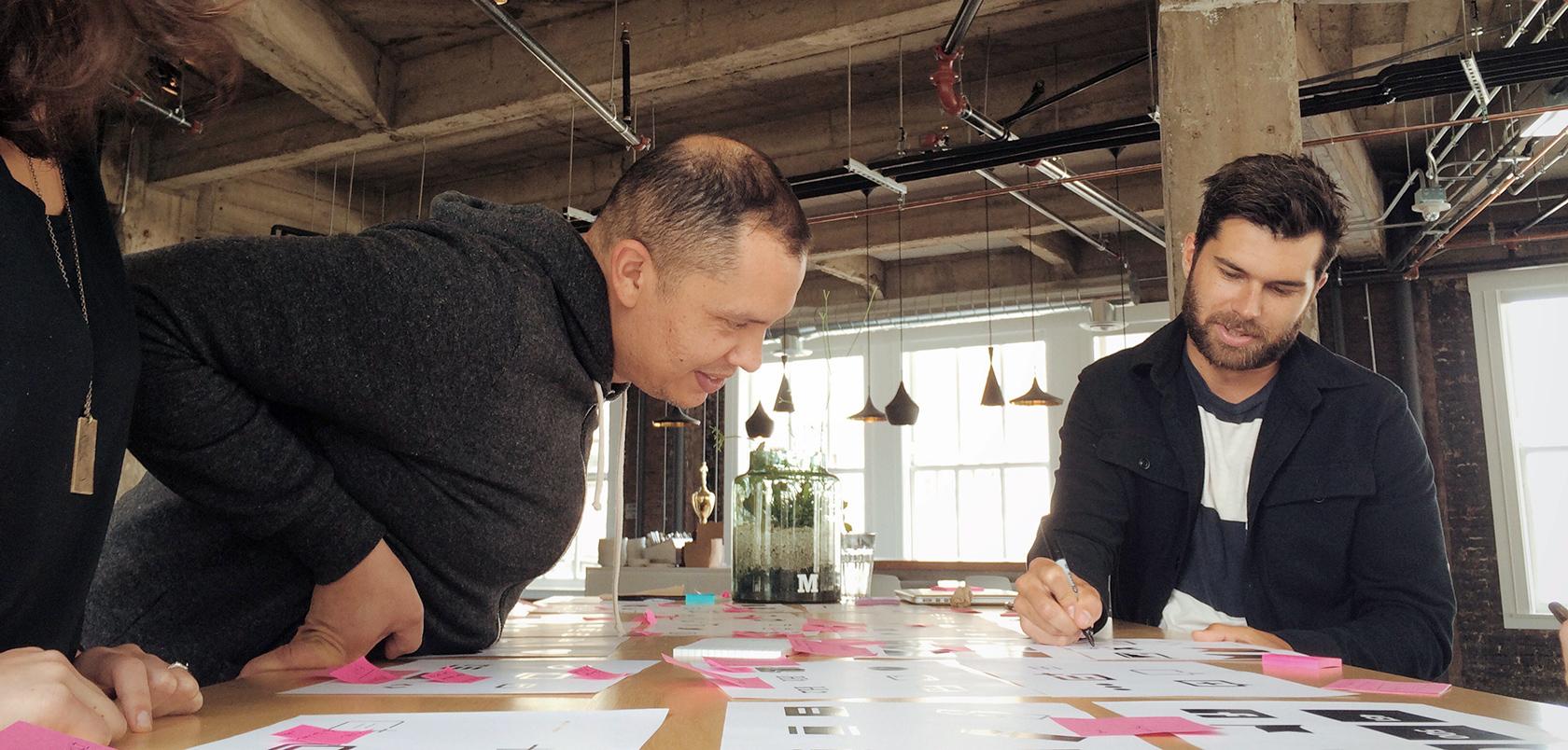Stay Cool: How to Take Design Feedback Strategically
Giving and receiving feedback—without losing one’s cool—is an art. It’s incumbent on designers to encourage others to give them quality design critiques on their work that cultivates constructive discussion.
Giving and receiving feedback—without losing one’s cool—is an art. It’s incumbent on designers to encourage others to give them quality design critiques on their work that cultivates constructive discussion.
Bree is a product designer and design manager, a creative problem-solver with a decade of experience in all facets of digital design.
PREVIOUSLY AT

Design is part art and part science. Designers apply their skills and knowledge to solve specific problems and support a client’s goals as well as those of the product’s end-users. To this end, at each stage of a project, designers should solicit (and welcome!) thoughtful design critiques that will help them arrive at an optimal design solution.
Being receptive to feedback, however, is its own challenge. Personal thought processes and creativity are up for critique by fellow designers as well as laymen. However, to be effective, designers need to learn not to take any reasonable design critique personally. For it to be useful, they must be able to interpret, assess, and apply it strategically to their process.
Preparing for Design Feedback
Getting quality design feedback is essential to the collaborative, iterative design process. Moreover, the best way to ensure that the feedback is useful is to start with a killer design review presentation. A confusing or ambiguous detail can derail a meeting and spark a long, tangential discussion that has nothing to do with the design or the issue at hand.
When soliciting design feedback on a particular solution, or trying to cultivate a meaningful discussion about an element of a design, the presentation sets the stage. An excellent presentation not only illustrates the solution but connects the audience to the process that was used to get there. If the audience is asked to weigh in on several choices or to offer fresh ideas, the presentation should present the problem that needs solving, as well as cover the journey so far.

The design review presentation format should be compatible with all the collaboration platforms and tools being used to share designs. Have stakeholders and the team been swapping static PDFs back and forth with minimal live discussion? Consider adding interstitial slides and notes that will guide a reader if they are working independently, and invite them to add comments. If using a collaboration tool like Red Pen, then there will be more real-time opportunities to guide the audience through the thought process.
Here are a few tips to help prepare a presentation that will encourage an audience to give valuable feedback:
1. Play to Your Audience
Feedback from a client should be viewed in a different light than that from other design professionals, colleagues, or a creative director. Clients offer a different perspective, and it’s important that other stakeholders consider their input with an open mind. Additionally, it’s very likely they will not be well-versed in how to give design feedback, so prepare the presentation with that in mind.
Feedback from Clients
When presenting to a client, try to anticipate their point of view. Typically, a client will have a vaguely formed idea that they find difficult to express in design terms; they have entrusted you with realizing their vision and shepherding it through the many pitfalls and challenges facing any production. Their response will be informed by many factors, including the product vision and hard reality of their business goals; they will be weighing not only the strength of the design but how well it aligns with these other factors. It is critical the presentation shows these factors have been considered, and comprehensively explains how the design will achieve the client’s goals.
For example, if discussing a sign-up flow for a site, the designer’s goal may be to provide the most friction-free experience possible. However, the client may feel that a streamlined solution misses valuable opportunities for revenue-generating ad placement. Consider this in advance and speak to this issue in the presentation. Is there data that proves the smoother experience may encourage more successful conversions than one that requires more steps? Prepare to honestly consider concerns offered by the audience during the UX feedback session against what the design team considers the optimal solution.

Feedback from Designers
Fellow designers, developers, and other members of the team will, quite naturally, have different concerns. Other designers will be considering the success of the solution and offering critiques to help strengthen it. The project manager will want to understand how the solution fits within the project’s requirements and scope. Developers will be anxious to comment on the feasibility and any foreseeable technical snags during implementation. Be thorough with the walkthrough, be sure to highlight areas where the intended audience may have concerns and the project will be well ahead of the game.
If looking for help in making a decision about complex navigation for a mobile app (for example), turn to the design chops and shared understanding of other designers on the team; leverage your common skills and similar experiences to encourage the most worthwhile discussion. Whether it’s usability or a layout issue, gear the presentation toward the core question, and walk the audience through some of the solutions that have already been explored. Why are the solutions not satisfying the design need? What questions can be answered that may help find a better solution?
Design critiques can be intimidating at first. If feeling a bit uncertain, Facebook’s team documented and shared a full critique of a design solution to give insight into the process and discussion. Check it out: Peek Inside a Facebook Design Critique.

2. Stay on Point
It is critical to avoid presenting details that muddy the waters. Base the fidelity and medium of the design artifact on what is to be discussed, and choose carefully. To demonstrate an interaction, for example, a lower-fidelity wireframe or interactive prototype will help the audience focus their response on the interaction. Mute colors or go grayscale. Save those highly-detailed screen mockups for focused discussions about visuals and color choice.

When a design is high-fidelity and polished, it can be difficult to get feedback on how well the design serves the use case scenario and user story. The design itself works against the process because the focus shifts and the scope becomes limited. The discussion narrows to examining details such as the speed of animation, the UI colors, or the color of a button.

It’s also important to establish expectations for the design presentation well in advance. Part of a designer’s role is to educate, particularly when dealing with a non-designer audience. Before showing a room full of business professionals a low-fi wireframe, explain briefly what the artifact is, and how it will more clearly demonstrate the specific solution that is to be discussed. They may be impatient to see everything in its shiny, finished form, but a quick overview will help everyone get on the same page.
If the whole breadth of a design package is being presented at once, organizing the foci is key to framing the proposal. Organize the chapters of the presentation that describe the big picture but also guide the audience through some of the finer points. If the holistic solution is presented, then highlight the major components that make it work, and finish with a return to how the whole big picture works; even clients seeing the package for the first time are usually able to follow and comment.

3. Your Thesis Is Your Mantra
How does the design solve the problem at hand? After several rounds of discovery, sketching, refining, and testing, does it fulfill the client’s goal?
As you present the concept, even if it seems obvious, remind others in the room of how it addresses the design problem. The audience may not have seen all the steps and been part of the process it took to arrive at the solution. This is particularly important when presenting to non-designers.
Regularly and confidently validating ideas against the core design problem is part of the iterative design process, so it makes sense to do so when presenting the solution. By articulating the reason design choices were made vis á vis the core requirements, the audience is reminded to consider the ideas based on those criteria as a priority. Ultimately, the questions or concerns they may have will help refine the concept even further and support the process toward the optimal design solution.

Receiving Feedback
Now that the solution has been presented, it’s time for the crucible! If the concepts have been presented confidently and clearly, while also anticipating the audience’s specific needs, it is most likely focused critique and useful suggestions will be returned. That doesn’t guarantee, however, that everyone will love the idea—and that’s ok. Remember these few tips while on the receiving end:
1. Keep Calm and Take Notes
Hopefully, the audience members have followed the reasoning, taken notes, and will be able to respond to the design as clearly as it was presented. Prepare to answer design feedback questions posed by the audience. Remember, they are offering assets that may be valuable to the project’s process. Listen to each point in its fullest, and take notes if necessary.
Depending on the responder, a succinct summation may be given, or the preference may be to walk through each detail of the presentation with comments, questions, and suggestions. It’s tempting to jump in and argue or defend a specific piece, but this might derail what could be a useful line of critique. What if the interjection cuts off what was shaping up to be a valuable suggestion? In this case, the goal of applying the feedback received in order to arrive at the best solution has effectively been subverted. Take a deep breath and make sure the full breadth of their reasoning has been heard before responding.
To avoid getting flustered or losing a critical point in the response, jot down a few notes as the audience is giving feedback. A side bonus to taking notes is that it will mitigate the impulse to interrupt. If presenting remotely, take advantage of a design feedback tool that captures the audience’s comments. Highlighting key takeaways from the discussion will not only help organize how to respond in turn but will help to strategize and apply the feedback to the next design iteration.

2. Ask: Is This Quality Feedback?
In the same way that some design is better than others, feedback also varies in quality. Great design feedback will help strengthen and improve the design. Bad design feedback—if handled improperly—can be a distraction that undermines everything.
Assess the quality of the responses received and whether or not there is a direction to be uncovered. Sometimes the feedback will be clear. Sometimes what comes back will not be immediately actionable, but a good designer learns through experience that there may be something useful hidden within.
If presenting a brand identity concept to a client and asking for feedback ahead of the next iteration, “I don’t like orange” would be less useful feedback because it tells very little about the design, and probably stems from personal preference rather than reflecting a core brand proposition. “Orange is too modern for our brand as we wish to present a more traditional face as a 30-year old company,” is much better design feedback in that it elucidates why the design choices do not solve the design problem and gives a starting point to refine the concept.
In order to judge whether or not it makes sense, try to match assess the design feedback against any discovery or user research that has been conducted. If someone makes a design suggestion that seems to contradict the research, reevaluate before implementing that suggestion.
The ability to distinguish good design feedback from bad is essential to the collaborative process—especially for a designer. Honed skills of interpretation and translation, and a keen sense for disarming ever-present focus bombs, are essential tools in a designer’s arsenal.

3. Don’t Take It Personally
There will be times in every designer’s career spent on the receiving end of some harsh criticism, and it is natural to become defensive.
We’ve all been there—a stakeholder giving website design feedback questions the thinking behind the design. Another person notices that an obvious use case wasn’t accounted for. Yet another calls out an unforgivable typo on the CTA button copy.
Take a deep breath and try to ease back the feeling of being attacked before beginning to respond. The essential thing to remember is that this isn’t personal. Even the best designers benefit from critical design feedback to help them get out of their heads, or past their biases. Whether on a large team of designers, or the sole consultant on a client project, this process is a collaboration toward arriving at the optimal design in order to solve a specific problem.

Responding to Feedback
Unless—and even if—the feedback amounts to a glowing green-light followed by a standing ovation, it’s important to respond (either in the same meeting or later) by addressing the feedback in a follow up:
1. Be Crystal Clear
First, confirm that everyone is on the same page about what was said in the response. An excellent place to start is by reiterating the feedback (easy if there were notes) to ensure essential points were understood. Just as the presentation benefits from clarity, so does the receipt of valuable design feedback. The most effective way of doing this is via email (if possible), as then it can be used as a handy checklist for any updates or changes to the next design iteration.
This is also a good time to ask questions to clarify any confusion or to press for design feedback on items that may not have received a specific response. Asking questions is especially helpful if the audience offered scant feedback in lieu of something that would inform the next set of design decisions.

2. Defend Your Decisions… Like a Boss
Did your audience miss the point? Is their counter-proposal suboptimal? Did they get hung up on the wrong details? Did they not understand the research presented to back up the interaction model? Never fear, there are many ways to support a solution without becoming defensive.
It’s best not to argue or attack the audience’s feedback. If what they say seems to miss the point, designers should try to reframe the explanation of why (and how) that solution, in particular, was conceived. If they seem intractable and there is continued disagreement with their feedback, let them know that more consideration will be given to what they’re saying moving forward. And do it! Some of the design feedback could be useful, so don’t throw the baby out with the bathwater by ignoring it completely. Begin the response by thanking them, and explaining how their input may be incorporated into the next iteration.
A designer should never apologize for their design decisions as if they were mistakes—even if they were a misfire. This comes off as amateurish and can shake a client or colleague’s confidence in their work.

3. You Got This
Positive design feedback doesn’t always mean a solution cannot be improved, and negative feedback doesn’t mean the presented ideas are terrible. Whatever the audience’s reaction, it is important to be open to their feedback without losing confidence in the original approach.
Careful preparation and focused attention on receiving input that will be most useful to the design process sets the stage for quality design critiques. By showing that the edge-cases and implications of the design have been considered will foster confidence in the team’s process. If a designer can take the harshest criticism professionally, everyone involved can be confident in their process to iterate and evolve a solution efficiently.
Aspiration leads to success (and adversity). Success creates its own adversity (and, hopefully, new ambitions). And adversity leads to aspiration and more success. It's an endless loop.
Ryan Holiday, Ego Is the Enemy
Design is a conversation. Whether it’s designing one small component as part of a larger team or delivering an entire UX/UI package for a complex mobile app, each round of feedback adds to a designer’s practice. Leading startups, as well as more established companies, leverage feedback gathered from a range of sources (clients, colleagues, research) to streamline as well as elevate the product. By taking design feedback well, listening and responding carefully, a designer can improve creatively, professionally, and even personally.
Further Reading on the Toptal Blog:
Understanding the basics
Why is feedback important in design?
Being able to take design feedback is a crucial element of a designer’s job—getting an objective opinion can help highlight small details that may have been missed. Positive design critique can help streamline and elevate the end result, as well as further them personally, creatively and professionally.
How do you give feedback to designers?
Often design teams, clients and other stakeholders are spread across a wide geographical area—using a design feedback tool to collaborate across time and space is an effective way to give constructive design critique (as well as trace and annotate content) while still considering the client’s vision.
How do I get good design feedback?
It’s critical for designers to learn how to take design feedback without becoming defensive. It helps to have clear expectations and set up an efficient process early in the game and revisit often. Be specific about what feedback would be most useful and how it aligns with goals and don’t be afraid to ask ‘why.’
How do you give professional feedback?
Be sure to keep design feedback about the work, not the designer. Always keep in view the project goals and customer needs. Establish trust, stay away from personal preferences. Don’t offer solutions but ask clear questions and explain why you feel the way you do.
How do you give and receive feedback effectively?
Whether you are there to give or take design feedback, asking pertinent design feedback questions is key. Be clear and specific. Be objective – don’t let personal preferences get in the way of project goals or the end user’s needs. Request a timeframe and how to communicate feedback (email, phone, in-person?).
Bree Chapin
New York, NY, United States
Member since May 15, 2016
About the author
Bree is a product designer and design manager, a creative problem-solver with a decade of experience in all facets of digital design.
PREVIOUSLY AT



